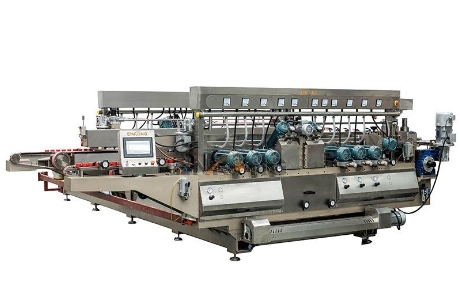Glass grinding is an essential and intricate process within the glass processing industry, playing a pivotal role in achieving the desired shape, size, and finish of glass edges. This meticulous procedure, however, is not without its challenges. Throughout the grinding process, several issues may arise, potentially compromising the quality and functionality of the glass edge. To address these concerns, this article will delve into some frequently encountered problems associated with glass grinding edges. Moreover, it will provide a comprehensive analysis of each issue, accompanied by effective solutions to ensure optimal outcomes.
What is glass edge grinding?
Glass edge grinding is a precise and meticulous process that involves the refinement and shaping of the edges of glass surfaces. It is undertaken to eliminate any sharp or jagged edges that may pose a safety risk, while also enhancing the overall visual quality of the glass. This intricate procedure employs advanced machinery and abrasive tools to grind, bevel, or polish the edges of the glass, resulting in a smooth and flawless finish.

The role of glass edge grinding is multifaceted and crucial across various industries:
Safety
One of the primary roles of glass edge grinding is to enhance safety. By removing sharp edges, burrs, and other imperfections, it significantly reduces the risk of injury during handling, installation, and use of glass products. This is particularly important in architectural applications, such as windows, doors, and partitions, where safety is paramount.
Aesthetic Enhancement
Glass edge grinding contributes to the overall visual appeal of glass products. The process creates a smooth, polished finish that enhances the appearance of the glass, making it more aesthetically pleasing. This is essential in architectural design, interior decoration, and artistic glasswork, where the quality and appearance of the glass are key considerations.
Functionality
In many applications, such as automotive windshields, glass tabletops, and display cases, precise edge grinding ensures that the glass fits seamlessly into its intended use. Smooth, accurately finished edges enable proper fitting and functionality within the final product, enhancing both performance and durability.
Customization and Design
Glass edge grinding allows for the customization of glass edges to meet specific design requirements. Beveled edges, chamfers, and custom profiles can be created through grinding, providing designers and architects with the flexibility to achieve their desired aesthetic and functional outcomes.
Quality Control
Edge grinding is an integral part of quality control in the glass manufacturing process. It ensures that glass products meet industry standards for smoothness, uniformity, and safety. By carefully refining the edges, manufacturers can deliver high-quality products that meet customer expectations and regulatory requirements.
Versatility
Glass edge grinding enables the use of glass in a wide range of applications. Whether it's for architectural glazing, decorative art installations, automotive components, or furniture, the ability to precisely grind and shape glass edges allows for its versatile use across diverse industries.
Edge Breakage
During glass grinding, edge breakage can occur, leading to cracks or complete detachment of the glass edge. This issue may arise due to excessive pressure, inadequate lubrication, or faulty machinery components. To prevent edge breakage, it is essential to maintain appropriate pressure levels, ensure proper lubrication with suitable coolant or oil, and regularly inspect and maintain the machinery to avoid any malfunctioning parts.
Edge Tapering
Edge tapering refers to the phenomenon where the thickness of the glass edge gradually decreases towards the end. This problem can be caused by uneven pressure distribution during the grinding process or improper alignment of the glass with the grinding wheel. Operators should ensure uniform pressure distribution throughout the grinding area, regularly inspect and align the glass position, and adjust the grinding parameters to eliminate edge tapering.
Glass scratches
Scratches can occur if the grinding wheel is contaminated with debris or if the glass comes into contact with abrasive particles during the grinding process. Regularly clean the grinding wheel and inspect it for any embedded particles. It's also important to use a smooth and even motion during grinding to minimize the risk of scratches.
Burnt edges of glass
Burnt edges can result from excessive heat generated during grinding. To prevent this, use a suitable grinding wheel speed and feed rate to ensure proper cooling and prevent overheating. Using a coolant or lubricant during grinding can also help dissipate heat and reduce the risk of burnt edges.
Glass sizes vary
Variations in glass sizes can occur due to imprecise cutting or inconsistent grinding. To address this issue, ensure that the glass is accurately measured and cut before grinding. Use precision tools and machinery to maintain consistent grinding dimensions. Regularly calibrate and monitor the grinding equipment to ensure accurate results.
Diagonal deviation
Diagonal deviation refers to uneven grinding angles or inconsistent beveling across the glass edges. This can be caused by improper alignment of the grinding wheel or uneven pressure during grinding. To correct diagonal deviation, ensure that the grinding wheel is properly aligned and that even pressure is applied during the grinding process. Regularly check and adjust the grinding equipment for optimal performance.
Edge Breakage
During glass grinding, edge breakage can occur, leading to cracks or complete detachment of the glass edge. This issue may arise due to excessive pressure, inadequate lubrication, or faulty machinery components. To prevent edge breakage, it is essential to maintain appropriate pressure levels, ensure proper lubrication with suitable coolant or oil, and regularly inspect and maintain the machinery to avoid any malfunctioning parts.
Glass grinding edge issues can significantly impact the overall quality and functionality of glass products. However, by understanding the common problems and implementing appropriate solutions, operators can enhance the precision, smoothness, and durability of glass edges. Regular maintenance, adherence to correct grinding parameters, and the use of suitable coolant and lubricants are essential for achieving optimal results in the glass processing industry.
Copyright © 2018 by Guangdong Enkong Machinery Co., Ltd. | All Rights Reserved Design by www.enkongmachinery.com
Hello, please leave your name and email here before chat online so that we won't miss your message and contact you smoothly.